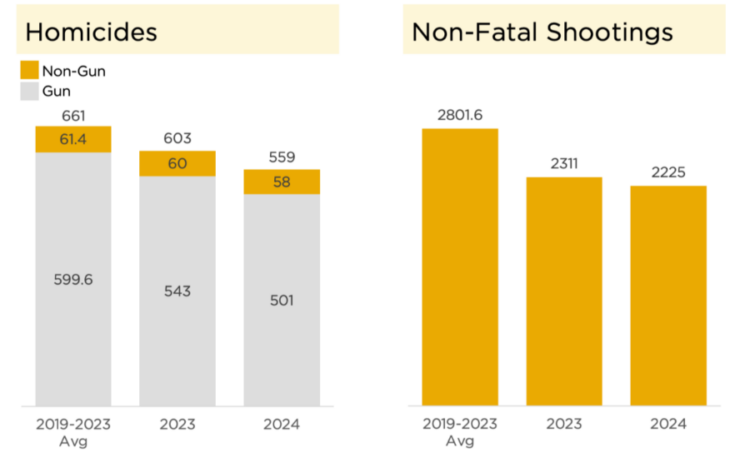End-of-Year Analysis: Chicago Crime Trends
Gun violence remains one of the most pressing challenges in America, but there are signs of progress.

This year in Chicago, murders and non-fatal shootings continued to decline from their recent peak in 2020 and 2021. Despite these encouraging trends, Chicago continues to grapple with inequities tied to race and geography, as well as increased violent crime on aggregate.
Signs of progress: Homicides decreased by 7.3% since this time last year, and non-fatal shootings decreased by 3.7%, remaining slightly above pre-pandemic figures.
Persistent challenging patterns:
- Black residents remain disproportionately impacted by gun violence, being 22 times more likely to be killed compared to White residents.
- The disparity is even greater when considering geography: neighborhoods with the highest homicide rates experience approximately 68 times more homicides than those with the lowest rates.
- While violent crime is down from last year, it is still higher than the 5-year average. The primary contributors to this upward trend are aggravated assaults, aggravated batteries, and robberies (excluding carjackings)

There is more work to do: Shootings in Chicago are becoming more deadly.
Since 2010,
- Shooting lethality—the rate at which shooting victims die from being shot—increased by 44.9%.
- The number of high-capacity magazines recovered at shootings by the Chicago Police Department increased by over 480%.
- The average number of shell casings recovered per shooting victim has more than doubled.

These numbers represent far more than statistics—they reflect lives lost, families grieving, and communities striving for safety and justice. At the University of Chicago Crime Lab, we release this data because understanding the full scope of gun violence is essential to finding solutions. By examining these trends and inequities in-depth, we hope to help policymakers and community leaders craft strategies that will support those most impacted by gun violence. We remain optimistic and committed to continuing our work toward safer, more equitable communities in the coming year.
Wishing you a happy and healthy start to 2025.


Katie Hill
Executive Director
University of Chicago Crime Lab
The Crime Lab’s unique ability to provide real-time R+D support to cities around the country depends on our ability to operate quickly and nimbly without waiting for long government and philanthropy funding cycles. Now, more than ever, demand for Crime Lab assistance vastly exceeds supply. Your support, in ways large and small, is what has allowed us to do this critical public safety work. This season, we humbly ask that you continue that support through a gift to the Crime Lab.
